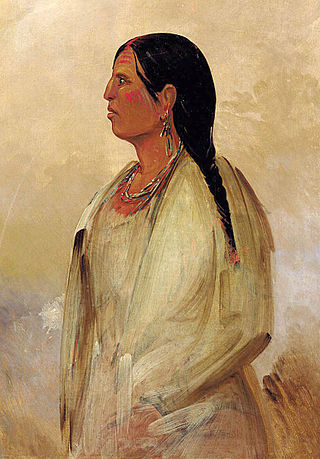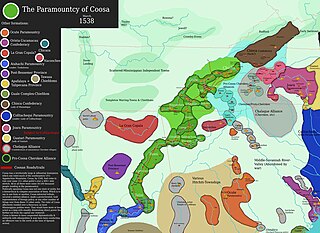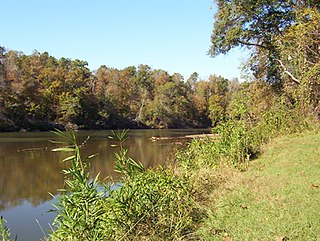Related Research Articles

The Muscogee, also known as the Mvskoke, Muscogee Creek or just Creek, and the Muscogee Creek Confederacy, are a group of related Indigenous peoples of the Southeastern Woodlands in the United States. Their historical homelands are in what now comprises southern Tennessee, much of Alabama, western Georgia and parts of northern Florida.
Muscogee mythology is related to a Muscogee tribe who are originally from the southeastern United States, also known by their original name Mvskoke, the name they use to identify themselves today. Mvskoke is their name in traditional spelling. Modern Muscogees live primarily in Oklahoma, Alabama, Georgia, and Florida. Their language, Mvskoke, is a member of the Eastern branch of the Muskogean language family. The Seminole are close kin to the Mvskoke and speak an Eastern Muskogean language as well. The Muscogee were considered one of the Five Civilized Tribes. After the Creek War many of the Muscogee escaped to Florida to create the Seminole.

Childersburg is a city in Talladega County in the U.S. state of Alabama. It was incorporated in 1889. At the 2020 census, the population was 4,754. It has a history dating back before 1540, when it was noted as a village of the Coosa Nation visited by the Spanish explorer Hernando de Soto. It is said a member of De Soto’s crew fell ill and was left to settle in the area of present day Childersburg where the Coosa people cared for the ill explorer. The Alabama Army Ammunition Plant, important during World War II, was located 4 miles (6 km) north of Childersburg.

The Creek War was a regional conflict between opposing Native American factions, European powers, and the United States during the early 19th century. The Creek War began as a conflict within the tribes of the Muscogee, but the United States quickly became involved. British traders and Spanish colonial officials in Florida supplied the Red Sticks with weapons and equipment due to their shared interest in preventing the expansion of the United States into regions under their control.

Etowah Indian Mounds (9BR1) are a 54-acre (220,000 m2) archaeological site in Bartow County, Georgia, south of Cartersville. Built and occupied in three phases, from 1000–1550 CE, the prehistoric site is located on the north shore of the Etowah River.
Red Sticks —the name deriving from the red-painted war clubs of some Native American Creek—refers to an early 19th century traditionalist faction of Muscogee Creek people in the Southeastern United States. Made up mostly of Creek of the Upper Towns that supported traditional leadership and culture, as well as the preservation of communal land for cultivation and hunting, the Red Sticks arose at a time of increasing pressure on Creek territory by European American settlers. Creek of the Lower Towns were closer to the settlers, had more mixed-race families, and had already been forced to make land cessions to the Americans. In this context, the Red Sticks led a resistance movement against European American encroachment and assimilation, tensions that culminated in the outbreak of the Creek War in 1813. Initially a civil war among the Creek, the conflict drew in United States state forces while the nation was already engaged in the War of 1812 against the British.

The Yuchi people are a Native American tribe based in Oklahoma. Their original homeland was in the southeast of the present United States.

Indigenous peoples of the Southeastern Woodlands, Southeastern cultures, or Southeast Indians are an ethnographic classification for Native Americans who have traditionally inhabited the area now part of the Southeastern United States and the northeastern border of Mexico, that share common cultural traits. This classification is a part of the Eastern Woodlands. The concept of a southeastern cultural region was developed by anthropologists, beginning with Otis Mason and Franz Boas in 1887. The boundaries of the region are defined more by shared cultural traits than by geographic distinctions. Because the cultures gradually instead of abruptly shift into Plains, Prairie, or Northeastern Woodlands cultures, scholars do not always agree on the exact limits of the Southeastern Woodland culture region. Shawnee, Powhatan, Waco, Tawakoni, Tonkawa, Karankawa, Quapaw, and Mosopelea are usually seen as marginally southeastern and their traditional lands represent the borders of the cultural region.

The Coosa chiefdom was a powerful Native American paramount chiefdom in what are now Gordon and Murray counties in Georgia, in the United States. It was inhabited from about 1400 until about 1600, and dominated several smaller chiefdoms. The total population of Coosa's area of influence, reaching into present-day Tennessee and Alabama, has been estimated at 50,000.
Hitchiti was a tribal town in what is now the Southeast United States. It was one of several towns whose people spoke the Hitchiti language. It was first known as part of the Apalachicola Province, an association of tribal towns along the Chattahoochee River. Shortly after 1690, the towns of Apalachicola Province moved to the central part of present-day Georgia, with Hitchiti joining most of those towns along Ochese Creek. In 1715, most of the towns on Ochese Creek, including Hitchiti, moved back to the Chattahoochee River, where the town remained until its people were forced to move to Indian Territory as part of the Trail of Tears.
Apalachicola Province was a group or association of towns located along the lower part of the Chattahoochee River in present-day Alabama and Georgia. The Spanish so called it because they perceived it as a political entity under the leadership of the town of Apalacicola. It is believed that before the 17th century, the residents of all the Apalachicola towns spoke the Hitchiti language, although other towns whose people spoke the Muscogee language relocated among the Apalachicolas along the Chattahoochee River in the middle- to later- 17th century. All of the Apalachicola towns moved to central Georgia at the end of the 17th century, where the English called them "Ochese Creek Indians". They moved back to the Chattahoochee River after 1715, with the English then calling them "Lower Creeks", while the Spanish called them "Ochese".

Fort Toulouse and Fort Jackson are two forts that shared the same site at the fork of the Coosa River and the Tallapoosa River, near Wetumpka, Alabama.

The history of Rome, Georgia extends to thousands of years of human settlement by ancient Native Americans. Spanish explorers recorded reaching the area in the later 16th century, and European Americans of the United States founded the city named Rome in 1834, when the residents of the area were still primarily Cherokee, before their removal on the Trail of Tears to Indian Territory. The competition for resources among its diverse inhabitants led to both innovation and strife. Its location at the confluence of three rivers enabled Rome to develop as a crossroads for trade and transportation. The city was later designated as the county seat of Floyd County, Georgia. Today, Rome is the largest city in Northwest Georgia, and is a regional center of healthcare, education, and manufacturing.

The Tallapoosas were a division of the Upper Creeks in the Muscogee Confederacy. Prior to Removal to Indian Territory, Tallapoosa lived along the Tallapoosa River in Alabama.
Hickory Ground, also known as Otciapofa is an historic Upper Muscogee Creek tribal town and an archaeological site in Elmore County, Alabama near Wetumpka. It is known as Oce Vpofa in the Muscogee language; the name derives from oche-ub,"hickory" and po-fau, "among". It is best known for serving as the last capital of the National Council of the Creek Nation, prior to the tribe being moved to the Indian Territory in the 1830s. It was added to the National Register of Historic Places on March 10, 1980.

Coweta was a tribal town and one of the four mother towns of the Muscogee Confederacy in what is now the Southeast United States, along with Kasihta (Cusseta), Abihka, and Tuckabutche.
Sophia Durant was a Koasati Native American plantation owner, who served as the speaker, interpreter, and translator for her brother, Alexander McGillivray, a leader in the Muscogee Confederacy.
Sehoy, or Sehoy I, was an 18th-century matriarch of the Muscogee Confederacy and a member of the Wind clan.

Fort Okfuskee was the name of two separate forts built by Great Britain in what is now Tallapoosa County, Alabama. The first fort was built to ensure British trade with the Creek Indians after the French constructed Fort Toulouse. The fort was abandoned a little over a decade after construction after facing difficulties in being supplied. A second Fort Okfuskee was built a year later, but was abandoned in less than a year due to lack of colonial support.
References
- Nabokov, Peter and Robert Easton; Native American Architecture.; New York; The Oxford University Press; 1989; ISBN 978-0-19-506665-4.
- Swanton, John R.; The Indians of the Southeastern United States; United States Government Printing Office; Washington, DC; 1946; p. 81-82.
- Waselkov, Gregory A.; and Smith, Marvin T.; Upper Creek Archaeology; referenced in McEwan, Bonnie G.; edition Indians of the Greater Southeast: Historical Archaeology and Ethnohistory; Gainesville; University of Florida Press; 2000; p. 244.